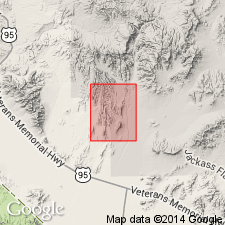
- Usage in publication:
-
- Paintbrush Tuff*
- Modifications:
-
- Areal extent
- AAPG geologic province:
-
- Great Basin province
Summary:
Paintbrush Tuff. Mapped in Topopah Spring SW quadrangle, Nye County, southeastern Nevada, where it includes Topopah Spring Member, 700 feet, Pah Canyon Member, as much as 150 feet, Yucca Mountain Member, as much as 175 feet, and Tiva Canyon Member, 400 feet. Underlies Rainier Mesa Member of Timber Mountain Tuff. Age is Miocene(?) and Pliocene.
[GNC remark (ca. 1967, US geologic names lexicon, USGS Bull. 1350, p. 551): The USGS currently designates the age of the Paintbrush Tuff as late Miocene on the basis of a study now in progress.]
Source: US geologic names lexicon (USGS Bull. 1350, p. 551).
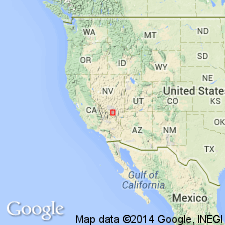
- Usage in publication:
-
- Paintbrush Tuff*
- Modifications:
-
- Original reference
- Dominant lithology:
-
- Tuff
- AAPG geologic province:
-
- Great Basin province
Summary:
Pg. A44-A51. Paintbrush Tuff of Piapi Canyon Group. Includes (ascending) Stockade Wash, Topopah Spring, Pah Canyon (new), Yucca Mountain Member, and Tiva Canyon Members. Yucca Mountain Member absent in Yucca Flat area. Underlies Timber Mountain Tuff (new). Term Survey Butte Member abandoned and rocks in this stratigraphic interval designated bedded tuff of Paintbrush Tuff. [Age is late Miocene.]
Type locality: Paintbrush Canyon, 2.5 mi northeast of Yucca Mountain, Nevada Test Site, Nye Co., southeastern NV.
[GNC remark (ca. 1967, US geologic names lexicon, USGS Bull. 1350, p. 551): The USGS currently designates the age of the Paintbrush Tuff as late Miocene on the basis of a study now in progress.]
Source: US geologic names lexicon (USGS Bull. 1350, p. 551).
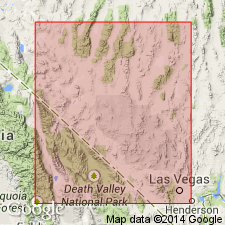
- Usage in publication:
-
- Paintbrush Tuff*
- Modifications:
-
- Geochronologic dating
- AAPG geologic province:
-
- Great Basin province
Summary:
K-Ar ages on biotite from Topopah Spring and Tiva Canyon Members of Paintbrush Tuff range from 12.4 to 13.2 Ma. Locations of samples shown on sketch map.
Source: GNU records (USGS DDS-6; Menlo GNULEX).
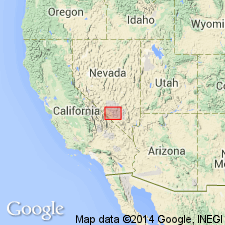
- Usage in publication:
-
- Paintbrush Tuff*
- Modifications:
-
- Revised
- AAPG geologic province:
-
- Great Basin province
Summary:
Lower contact revised; Stockade Wash, formerly considered the lower member of the Paintbrush Tuff, removed and assigned formation rank. Divided into four named members (ascending): Topopah Spring, Pah Canyon, Yucca Mountain, and Tiva Canyon, and unnamed bedded tuffs which separate the named members at many localities. Also includes some informally designated tuffs and lavas at top--such as the tuff of Pinyon Pass, pre-Rainier Mesa lavas, etc. Distribution maps for named members. They extend from southwest Lincoln Co, northwest Clark Co across southern Nye Co, NV into easternmost Inyo Co, CA in the Great Basin province. Erupted from the Claim Canyon cauldron in Miocene time. Stratigraphic chart. Overlies unnamed bedded tuffs and rhyolites of Area 20. Underlies Rainier Mesa Member of Timber Mountain Tuff. Modal analyses.
Source: GNU records (USGS DDS-6; Denver GNULEX).
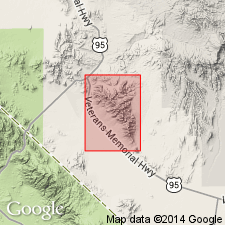
- Usage in publication:
-
- Paintbrush Tuff*
- Modifications:
-
- Age modified
- AAPG geologic province:
-
- Great Basin province
Summary:
Age of Paintbrush Tuff in report area [Bare Mountain, Nye Co, NV] is middle Miocene based on radiometric ages ranging from approximately 15 to 12.8 Ma. [Based on 1983 DNAG Geologic Time Scale age equals middle Miocene.]
Source: GNU records (USGS DDS-6; Menlo GNULEX).
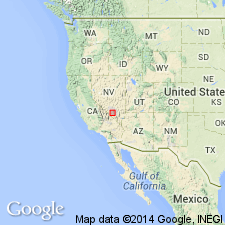
- Usage in publication:
-
- Paintbrush Group*
- Modifications:
-
- Revised
- Geochronologic dating
- AAPG geologic province:
-
- Great Basin province
Summary:
Within southwest Nevada volcanic field, Nye Co, NV, Great Basin province, units previously of formation rank are raised to group rank to allow for combining petrographically, geochemically, and temporally related lava flows and nonwelded tuffs with the principal correlative welded ash-flow tuff sheets (formerly members of the previous formation-rank tuffs). The ash-flow sheets are raised to formation rank and designated as "Tuff." Paintbrush consists of (ascending) Topopah Spring, Pah Canyon, Yucca Mountain, and Tiva Canyon Tuffs (all ranks raised). [Paintbrush also consists of informal units not discussed in this report.] Younger than Calico Hills Formation (new); older than Timber Mountain Group (rank raised). [Though not addressed by authors, raising Timber Mountain and Paintbrush to group ranks necessitates raising Piapi Canyon Group to Piapi Canyon Supergroup.] Nomenclature on table 1. Ar40/Ar39 dates from an average of 4 sanidine samples from Topopah Spring yielded an age of 12.8 +/-0.03 Ma and from an average of 3 sanidine samples from Tiva Canyon yielded an age of 12.7 +/-0.03 Ma (Miocene).
Source: GNU records (USGS DDS-6; Denver GNULEX).
For more information, please contact Nancy Stamm, Geologic Names Committee Secretary.
Asterisk (*) indicates published by U.S. Geological Survey authors.
"No current usage" (†) implies that a name has been abandoned or has fallen into disuse. Former usage and, if known, replacement name given in parentheses ( ).
Slash (/) indicates name conflicts with nomenclatural guidelines (CSN, 1933; ACSN, 1961, 1970; NACSN, 1983, 2005, 2021). May be explained within brackets ([ ]).

